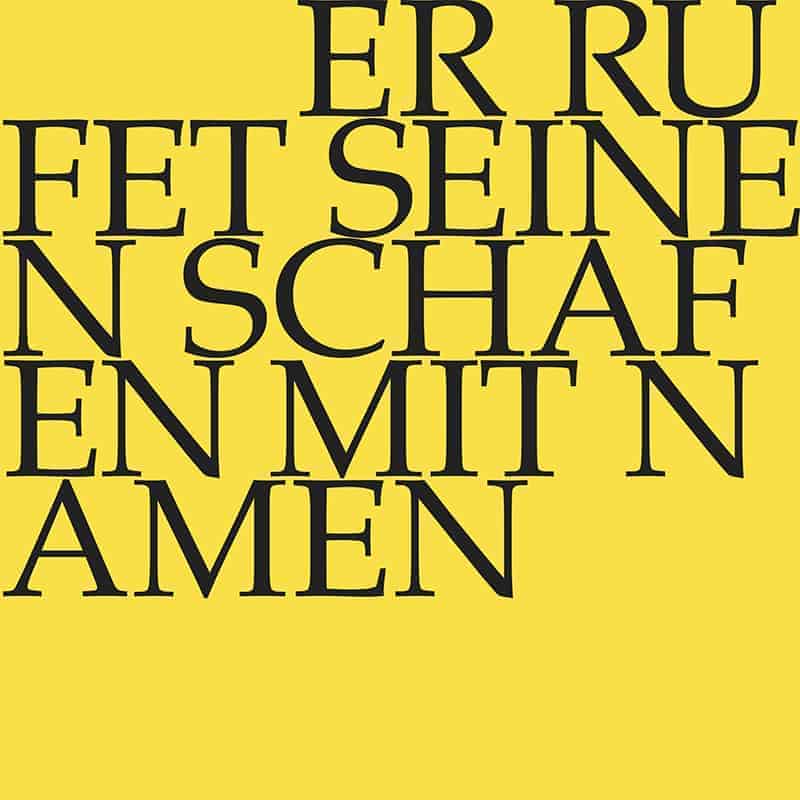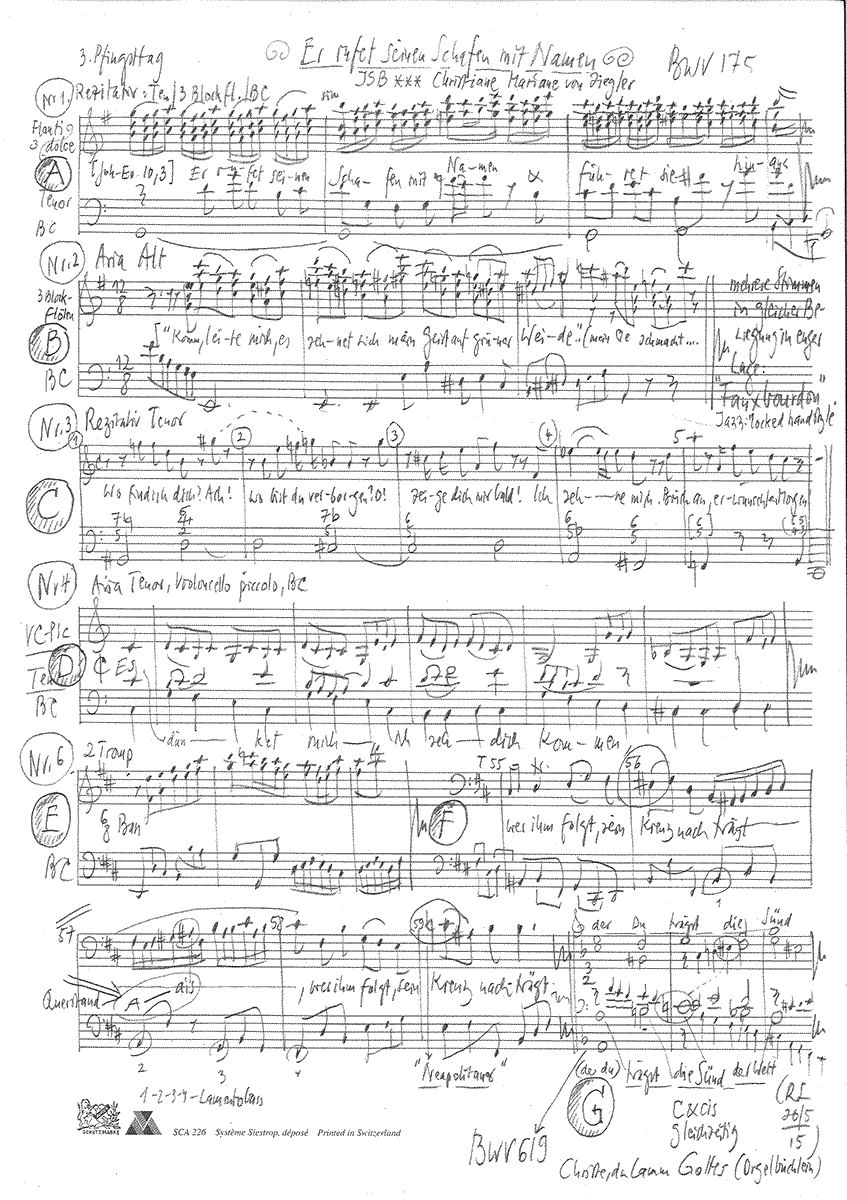Er rufet seinen Schafen mit Namen
BWV 175 // For the Third Day of Pentecost
(He calleth his own sheep by name) for alto, tenor and bass, vocal ensemble, flauto dolce I-III, tromba I+II, violoncello piccolo, strings and basso continuo
Composed for the Third Day of Pentecost in 1725, the cantata “Er rufet seinen Schafen mit Namen” (He calleth his own sheep by name) belongs to a cycle of works set to nine texts by Christiane Mariane von Ziegler, the daughter of a patrician family from Leipzig. Bach worked on the cycle between Easter and Trinity Sunday of 1725, a period during which his choral cantata project had been temporarily abandoned. The cantata is distinctive not only for its colourful instrumentation, but also for the fact that the libretto draws heavily on readings from the Gospel of John – so much so that the American musicologist Eric Chafe suggests the work should be viewed in connection with Bach’s St John Passion.

Would you like to enjoy our videos ad-free? Subscribe to YouTube Premium now...
Workshop
Reflective lecture
Orchestra
Conductor & cembalo
Rudolf Lutz
Violin
Renate Steinmann, Monika Baer
Viola
Susanna Hefti
Violoncello
Martin Zeller
Violoncello piccolo
Martin Zeller
Violone
Iris Finkbeiner
Bassoon
Susann Landert
Tromba da tirarsi
Patrick Henrichs, Peter Hasel
Recorder/Flute
Annina Stahlberger, Teresa Hackel, Claudia Heinisch
Organ
Nicola Cumer
Musical director & conductor
Rudolf Lutz
Workshop
Participants
Karl Graf, Rudolf Lutz
Reflective lecture
Speaker
Rüdiger Safranski
Recording & editing
Recording date
22/05/2015
Recording location
Trogen
Sound engineer
Stefan Ritzenthaler
Director
Meinrad Keel
Production manager
Johannes Widmer
Production
GALLUS MEDIA AG, Switzerland
Producer
J.S. Bach Foundation of St. Gallen, Switzerland
Librettist
Text No. 2–6
Christiane Mariana von Ziegler
Text No. 1
John 10:3
Text No. 7
Johann Rist, 1651
First performance
Third Day of Pentecost,
22 May 1725
In-depth analysis
The introductory movement presents a quotation from the Gospel of John (“He calleth his own sheep by name then and leadeth them outside!”) accompanied by the pastoral tones of three recorders, whose gently undulating lines distinguish Jesus as the loyal shepherd. This scoring – unusual in Bach’s oeuvre – also characterises the following alto aria “Come, lead me out”, which conveys a deep personal conviction of the biblical promise. With their whispered sounds of longing (“My heart doth yearn”), the recorders bring to this movement the distinct level of meaning that, in addition to the memento mori and pastoral allusions, the instrument embodied in the baroque period. This siciliano setting sustains the key of E minor throughout and, with its descending figure, alludes to a transience and grief that captures the mood of Jesus’ words of farewell so prominently placed in the Gospel of John.
The tenor recitative, a questioning search for the beloved shepherd, is underscored by instable harmonies that ultimately resolve in an energetic gesture of awakening (“Break forth, O welcome morning!”). By contrast, the ensuing aria is accompanied by a sonorous violoncello piccolo whose clear timbre gives cogent expression to the “voice so graceful, so full of love and gentleness” of which the tenor sings. The violincello piccolo then takes up a lively duo with the bassoon in the upper register, a parody setting based on the birthday cantata “Illustrious Leopold” (BWV 173a) composed in Cöthen. Although the flattering Cöthen original – “Thy name shall like the sun go forth” – was likewise accompanied by obbligato violoncello and bassoon, in his sacred parody version, Bach nevertheless had to fit in an additional four lines of text.
The third recitative, an intentional disruption, features a dialogue in which the voices portray atypical roles: the alto, which usually represents the human soul, expresses the incredulity of the disciples as described in the Gospel, while the bass, often the personification of Jesus, speaks of the fallacy of human reason, likening it to a form of spiritual deafness. In this setting, the bass soloist shifts swiftly from the role of an earthly sinner (“We mortals”) to an energetic preacher who implores his people to embrace Christ the Saviour; the fact that the string parts become lively and quicken upon the mention of Christ’s name may be viewed as a recurring topos in Bach’s oeuvre.
The following bass aria “Open ye both ears and listen”, by contrast, is one of Bach’s most remarkable creations. Drawing on Italian models, Bach relies on an orchestration including two trumpets but no timpani – unique in his oeuvre – to render a powerful scene of Lutheran victory that transforms the will to hear the Good News into an acoustic phenomenon. Despite the occasional fanfare, the trumpet parts are markedly cantabile and consonant, and are quite demanding on the musicians – with quiet triumph and no sign of servility, they present the Easter prince as 47 a friendly leader who wields his power only at a distance. Although the setting has not been identified as a parody, it is not implausible that at least the da-capo framework is based on an earlier secular work; the middle section, by contrast, is clouded by pained tones that serve as a reminder of what living a life of Christ actually involves (“Who obeys, his cross doth bear”).
With the return of the recorder timbre in the closing chorale, the movement is lent a Pentecostal brilliance that brings the work full circle. This powerful setting to Johann Rist’s pithy hymn verse is borrowed from the Pentecost cantata BWV 59, which, accompanied by strings only, was set to Luther’s text “Come Holy Spirit, God the Lord”.
Libretto
1. Rezitativ (Tenor)
«Er rufet seinen Schafen mit Namen
und führet sie hinaus.»
2. Arie (Alt)
Komm, leite mich,
es sehnet sich
mein Geist auf grüner Weide!
Mein Herze schmacht’,
ächzt Tag und Nacht,
mein Hirte, meine Freude.
3. Rezitativ (Tenor)
Wo find’ ich dich?
Ach, wo bist du verborgen?
O! Zeige dich mir bald!
Ich sehne mich.
Brich an, erwünschter Morgen!
4. Arie (Tenor)
Es dünket mich, ich seh dich kommen,
du gehst zur rechten Türe ein.
Du wirst im Glauben aufgenommen
und mußt der wahre Hirte sein.
Ich kenne deine holde Stimme,
die voller Lieb und Sanftmut ist,
daß ich im Geist darob ergrimme,
wer zweifelt, daß du Heiland seist.
5. Rezitativ (Alt, Bass)
alt
«Sie vernahmen aber nicht, was es war,
das er zu ihnen gesaget hatte.»
bass
Ach ja! Wir Menschen sind oftmals den
Tauben zu vergleichen: wenn die verblendete
Vernunft nicht weiß, was er gesaget hatte.
O! Törin, merke doch, wenn Jesus mit dir
spricht, daß es zu deinem Heil geschicht.
6. Arie (Bass)
Öffnet euch, ihr beiden Ohren,
Jesus hat euch zugeschworen,
daß er Teufel, Tod erlegt.
Gnade, Gnüge, volles Leben
will er allen Christen geben,
wer ihm folgt, sein Kreuz nachträgt.
7. Choral
Nun, werter Geist, ich folge dir;
hilf, daß ich suche für und für
nach deinem Wort ein ander Leben,
das du mir willt aus Gnaden geben.
Dein Wort ist ja der Morgenstern,
der herrlich leuchtet nah und fern.
Drum will ich, die mich anders lehren,
in Ewigkeit, mein Gott, nicht hören.
Alleluja, Alleluja!



